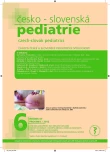Diagnostics and therapy of neurogenic bladder in children
Authors:
J. Trachta; J. Kříž
Authors‘ workplace:
Klinika dětské chirurgie UK 2. LF a FN Motol, Subkatedra dětské chirurgie IPVZ, Praha
přednosta prof. MUDr. J. Šnajdauf, CSc.
Published in:
Čes-slov Pediat 2012; 67 (6): 394-401.
Category:
Review
Overview
Neurogenic bladder in children is a serious dysfunction of lower urinary tract originating due to inborn or acquired disease of spinal cord and spinal nerves. It is a part of multiple defects and belongs to chronic pathological conditions, which is difficult to solve. The chief aim in the care of children with neurogenic bladder is to prevent infections and deterioration of the function of upper urinary tract as well as to reach urinary and fecal continence at the older age. In order to reach these goals, repeated examinations are required as well as lifelong follow-up and correctly timed therapy.
The basic examinations include, besides ultrasound, urodynamic studies and a clean intermittent catheterization of urinary bladder is the basic therapeutic procedure, if need be supplemented administration of anticholinergics. The recent knowledge of pediatricians and children urologists recommends the first urodynamic examination of patients with inborn defect, which is responsible for development of neurogenic bladder, as early as at the suckling age. The training of the clean intermittent catheterization is recommended differently, from the newborn to preschool age, but there is a general tendency to start with the catheterization much earlier than the practice was in the seventies to nineties. The early introduction of intermittent catheterization makes it an obvious constituent of everyday routine and it also significantly decreases the need of bladder augmentation at the older age. Even so a small part of patients which are refractory to conservative treatment the surgery becomes necessary. In most cases in is the augmentation urinary bladder, so called formation of low-pressure and large capacity urinary reservoir or a surgery resulting in improvement of incontinence. Some interventions, for instance the establishment of continent vesicostomy, may be indicated even to meet the patient’s wishes.
Key words:
neurogenic bladder, urodynamic examination, clean intermittent catheterization, oxybutynin, bladder augmentation, incontinence, continent vesicotomy
Sources
1. Mrázková O. Orgány močového ústrojí. In: Dylevský I, Druga R, Mrázková O. Funkční anatomie člověka. Praha: Grada, 2000: 361–381.
2. Raymond R, Sandip PV, Farzeen F. Neurogenic bladder. eMedicine 2009: http://emedicine.medscape.com/article/453539-overview.
3. MacLellan LD, Bauer SB. Phy-siology of the lower urinary tract. In: Esposito C, Guys JM, Gough D, et al. Pediatric Neurogenic Bladder Dysfunction. Springer, 2006: 13–20.
4. Cerruto MA, Artibani W. Urodynamics. In: Esposito C, Guys JM, Gough D, et al. Pediatric Neurogenic Bladder Dysfunction. Springer, 2006: 133–146.
5. Tichý M. Neurochirurgie. In: Šnajdauf J, Škába R, et al. Dětská chirurgie. Praha: Galén, 2005: 87–117.
6. Gregor V, Šípek A, Horáček J, et al. Prenatální diagnostika vrozených vad v České republice – aktuální data. Prakt Lék 2011; 91 (2): 85–90.
7. Lee H, Albanese CT. Fetal surgery for myelomeningocele. In: Esposito C, Guys JM, Gough D, et al. Pediatric Neurogenic Bladder Dysfunction. Springer, 2006: 285–287.
8. Stein R, Weisner Ch, Beetz R, et al. Urinary diversion in children and adolescents wit In: European Society of Paediatric Urology, Update on Paediatric Urology. Madrid, 2009: 113–123.
10. Aigrain Y, El Ghoneimi A. Neurogenic bladder. In: Puri P, et al. Pediatric Surgery. Springer, 2009: 881–889.
11. Tekgül S, Riedmiller H, Gerharz E, et al. Managment of neurogenic bladder in children. In: European Society for Paediatric Urology, Guidelines on Paediatric Urology, 2009: 31–41.
12. Sillén U, Abrahamsson K. The voiding diary. In: Esposito C, Guys JM, Gough D, et al. Pediatric Neurogenic Bladder Dysfunction. Springer, 2006: 109–116.
13. Favazza TF, Koo HP. Myelodysplasia and neurogenic bladder dysfunction. eMedicine 2010: http://emedicine.medscape.com/article/1015695-overview.
14. Hanuš T. Intermitentní katetrizace močového měchýře. Čas Lék čes 1983; 122 (37): 1135–1137.
15. De Jong TPV, Chrzan R, Klijn AJ, et al. Treatment of the neurogenic bladder in spina bifida. Pediatr Nephrol 2008; 23 (6): 889–896 (http://www.ncbi.nlm.nih.gov/pmc/articles/PMC2335291/?tool=pubmed).
16. Pereira PL, Urrutia MJM, Jaureguizar E. Pharmacological therapy in neuropathic bladder. In: Esposito C, Guys JM, Gough D, et al. Pediatric Neurogenic Bladder Dysfunction. Springer, 2006: 169–183.
17. Schurch B, Karsenty G, Corcos J. Botulinum toxin injections to treat neurogenic bladder – sphincter dysfunction in pediatric patients. In: Esposito C, Guys JM, Gough D, et al. Pediatric Neurogenic Bladder Dysfunction. Springer, 2006: 199–202.
18. Signorelli F, Lavano A, Volpentesta G. Neurosurgical treatment of neurogenic bladder dysfunction. In: Esposito C, Guys JM, Gough D, et al. Pediatric Neurogenic Bladder Dysfunction. Springer, 2006: 271–276.
19. Dvořáček J, et al. Augmentace močového měchýře. Urologie 2006; III: 1611–1629.
20. Pereira PL. Bladder augmentation. In: European Society of Paediatric Urology, Update on Paediatric Urology. Madrid, 2009: 123–127.
21. Landau EH, Jayanthi VR, Khoury AE, et al. Bladder augmentation: ureterocystoplasty versus ileocystoplasty. J Urol 1994; 152 (2Pt2): 716–719.
22. Esposito C, De Fazio C, Svanelli A. Neurogenic bladder dysfunction: A condition at increased risk of bladder malignancy? In: Esposito C, Guys JM, Gough D, et al. Pediatric Neurogenic Bladder Dysfunction. Springer, 2006: 305–309.
23. Esposito C, Savanelli C, Leggio S, et al. Latex allergy in children with spina bifida. In: Esposito C, Guys JM, Gough D, et al. Pediatric Neurogenic Bladder Dysfunction. Springer, 2006: 329–339.
24. Liard A, Elbaz F, Bachy B. Managment of constipation in neurogenic bladder dysfunction. In: Esposito C, Guys JM, Gough D, et al. Pediatric Neurogenic Bladder Dysfunction. Springer, 2006: 257–262.
25. Farrant B, Sawyer SM. Sexuality in young people with neurogenic bladder dysfunction. In: Esposito C, Guys JM, Gough D, et al. Pediatric Neurogenic Bladder Dysfunction. Springer, 2006: 317–323.
Labels
Neonatology Paediatrics General practitioner for children and adolescentsArticle was published in
Czech-Slovak Pediatrics

2012 Issue 6
Most read in this issue
- Quality of life and morbidity in children after repair of congenital diaphragmatic hernia
- Difficulties in prenatal diagnostics trisomy 20 and its mosaic
- Acute disseminated encephalomyelitis – case report
- Diagnostics and therapy of neurogenic bladder in children
